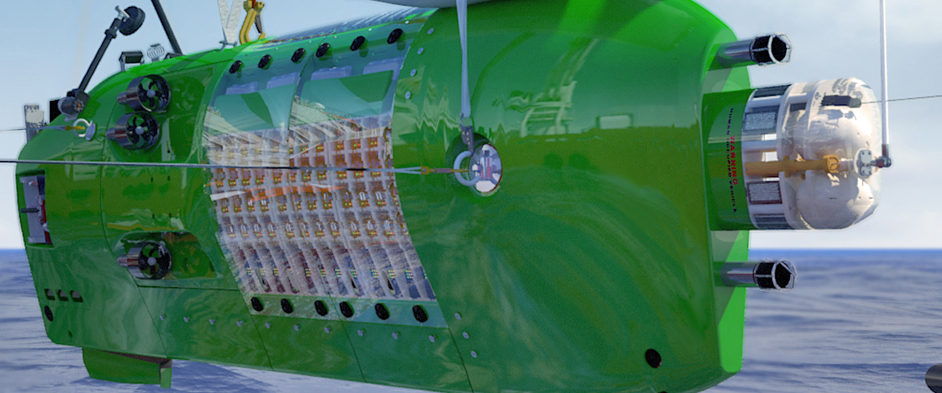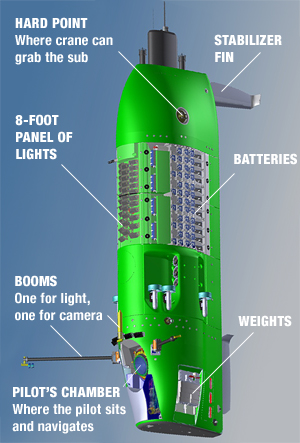THE SUB

Editor’s note: On March 26, 2012, James Cameron made a record-breaking solo dive to the Earth’s deepest point, successfully piloting the DEEPSEA CHALLENGER nearly 7 seven miles (11 kilometers) to the Challenger Deep in the Mariana Trench. DEEPSEA CHALLENGE is now in its second phase—scientific analysis of the expedition’s findings. Click here for news about the historic dive, an exclusive postdive interview with Cameron, and information about the next phase of the expedition.
Making the nearly 7-mile (11-kilometer) descent to the deepest place on Earth, exploring the ocean floor, conducting experiments, collecting samples, and returning safely to the surface requires a craft unlike any other—a “moon lander” for a place less understood, more forbidding, and perhaps less forgiving than the farthest reaches of space.

Illustration courtesy Acheron Project Pty Ltd
DEEPSEA CHALLENGER
The challenge is every bit as daunting as building a vehicle to take a person to Mars. Conditions at the unexplored frontier of Earth’s deepest point are perhaps even more extreme than they are on the moon. The pressure of the ocean so many miles beneath the waves is crushing, the water is near freezing, and there is perpetual darkness. You are surrounded by dramatic geology at the edge of Earth’s colliding tectonic plates, and who knows what forms of life are out there beyond the range of your lights. If anything goes wrong, it’s a long, long way home.
Incorporating new technologies, designs, and materials, the submersible DEEPSEA CHALLENGER is the product of years of dreaming, planning, building, and testing. From its one-of-a-kind vertical attitude to its innovative materials, including a highly sophisticated syntactic foam developed specifically to withstand the pressure at the bottom of the ocean, the craft is a showcase of engineering innovation. Above all, it is designed for safety—every critical function has multiple backup systems, from human life support to power, communications, and the mechanisms that return the sub to the surface of the ocean.
In building the DEEPSEA CHALLENGER, Cameron and his team of engineers and scientists wanted to accomplish several objectives:
- To create and operate a vehicle that can carry a human pilot to the deepest sites in Earth’s oceans and perform work with significant bottom time for research activities;
- To demonstrate the ability to dive repeatedly at any given site to gather data, samples, and imagery to create a comprehensive data set;
- To demonstrate the effectiveness of a human-piloted vehicle as a science platform for investigation in the hadal zone, the deepest part of the ocean;
- To demonstrate the successful interaction of piloted, unpiloted, and remotely piloted platforms to perform a broad range of science tasks in concert;
- Beyond just these demonstrations of capability, to return the maximum actual science value from the first expedition;
- To bring back compelling imagery in 3-D of never before seen geological processes and species. This will inspire public interest in exploration and in scientific study of the deep ocean, especially among young people who must become our future scientists, engineers, and explorers.



